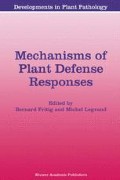Abstract
A rapid and transient generation of activated oxygen from the elicitor-treated soybean cell suspension was detected with luminol-mediated chemiluminescense, and its generation was inhibited by addition of radical scavengers. Direct evidence for the existence of phosphatidylcholine hydroperoxide (PCOOH) and determination of the changes in PCOOH after treatment of soybean seedlings with fungal elicitor were examined using chemiluminescence-HPLC of hydroperoxide specific assay. PCOOH was transiently accumulated within 6 h after elicitor treatment preceding the induction of phytoalexin, but such event was not observed in control plants, thus suggesting that accumulation of PCOOH was a response to fungal elicitor in host plant. These rapid responses may be involved in the triggering of a plant defense mechanism against fungal invasion.
Access this chapter
Tax calculation will be finalised at checkout
Purchases are for personal use only
Preview
Unable to display preview. Download preview PDF.
References
Asada, A., Bushnell, W. R., Ouchi, S. and Vance, C. P. (1982) Plant Infection, Japan sientific societies Press, Tokyo, Spring-Verlag, Berlin
Kondo, Y., Miyazawa, T. and Mizutani, J. (1992) ‘Detection and time course analysis of phospholipid hydroperoxide in soybean seedlings after treatment with fungal elicitor, by CL-HPLC assay ’ Biochim. Biophys. Acta , in press
Miyazawa, T., Yasuda, K. and Fujimoto, K. (1987)‘Chemiluminescence-high performance liquid chromatography of phosphatidylcholine hydroperoxide ’ Anal. Lett, 20, 915–925
Miyazawa, T., Yasuda, K., Fujimoto, K. and Kaneda, T. (1990) ‘Phospholipid accumulation in liver of rats intoxicated with cabon tetrachloride and its inhibition by dietary α-tocopherol’ J. Biochem., 103,744–746
Darvill, A. G. and Albersheim, P. (1984) ‘Phytoalexin and their elicitor ’, Ann. Rev. Plant Physiol., 35, 243–275
Kosugi, H. and Kikugawa, K. (1989) ‘ Potential thiobarbituric acid-reactive substances in peroxidized lipids ’ Free radical Biol. Med., 7, 205–207
Author information
Authors and Affiliations
Editor information
Editors and Affiliations
Rights and permissions
Copyright information
© 1993 Springer Science+Business Media Dordrecht
About this chapter
Cite this chapter
Kondo, Y., Hanawa, F., Miyazawa, T., Mizutani, J. (1993). Detection of Rapid and Transient Generation of Activated Oxygen and Phospholipid Hydroperoxide in Soybean after Treatment with Fungal Elicitor by Chemiluminescence Assay. In: Fritig, B., Legrand, M. (eds) Mechanisms of Plant Defense Responses. Developments in Plant Pathology, vol 2. Springer, Dordrecht. https://doi.org/10.1007/978-94-011-1737-1_38
Download citation
DOI: https://doi.org/10.1007/978-94-011-1737-1_38
Publisher Name: Springer, Dordrecht
Print ISBN: 978-94-010-4761-6
Online ISBN: 978-94-011-1737-1
eBook Packages: Springer Book Archive

